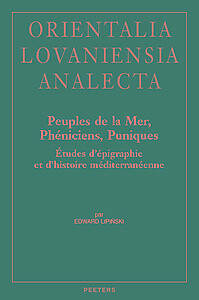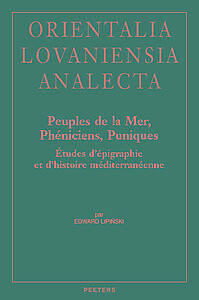
- Afhalen na 1 uur in een winkel met voorraad
- Gratis thuislevering in België vanaf € 30
- Ruim aanbod met 7 miljoen producten
- Afhalen na 1 uur in een winkel met voorraad
- Gratis thuislevering in België vanaf € 30
- Ruim aanbod met 7 miljoen producten
Zoeken
Peuples de la Mer, Phéniciens, Puniques
Études d'épigraphie et d'histoire méditerranéenne
E. Lipinski
€ 85,00
+ 170 punten
Omschrijving
The volume contains studies dealing with Mediterranean history in the first millennium B.C., based mainly on epigraphic data. Chapter I concerns the Philistines and the kingdom of "terra firma", established by "Sea Peoples" on the Lower and Middle Orontes and in the Aleppo area, showing their Mycenaean background. Their obvious relations with the Phoenicians lead to the presentation of the newly identified material referring to the goddess Tanit, best known from Carthage, but coming from the Levant. Information provided by classical sources is then discussed in two chapters dealing with Herodotus and with later sources giving some information on Phoenician and Punic law and jurisprudence. The second part of the book consists of an analysis of Phoenician, Punic, and Neo-Punic inscriptions which so far have not been fully deciphered or interpreted. Most of them come from North Africa, but inscriptions from Ibiza and Sardinia are examined as well. Some of them offer the possibility of better understanding the molk-sacrifice and its human implications, especially in the second and first centuries B.C. Attention is paid also to the meaning and the implications of some personal names appearing in those inscriptions.
Specificaties
Betrokkenen
- Auteur(s):
- Uitgeverij:
Inhoud
- Aantal bladzijden:
- 369
- Taal:
- Frans
- Reeks:
- Reeksnummer:
- nr. 237
Eigenschappen
- Productcode (EAN):
- 9789042931619
- Verschijningsdatum:
- 24/03/2015
- Uitvoering:
- Hardcover
- Formaat:
- Genaaid
- Afmetingen:
- 169 mm x 248 mm
- Gewicht:
- 889 g

Alleen bij Standaard Boekhandel
+ 170 punten op je klantenkaart van Standaard Boekhandel
Beoordelingen
We publiceren alleen reviews die voldoen aan de voorwaarden voor reviews. Bekijk onze voorwaarden voor reviews.








